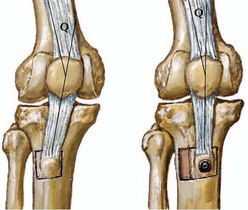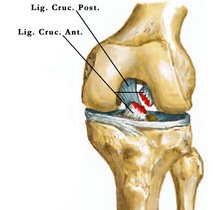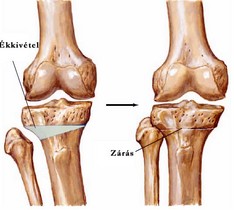Additional surgeries
Anterior cruciate ligament repair, meniscal tear removal, axial deviation of the knee, mal-tracking of the knee cap.
In most cases cartilage defect is a result of a preceding sports injury affecting additional structures of the injured knee. Repair of the associated injuries is just as important as the cartilage repair itself.
One of the most common sports injuries is the rupture of the anterior cruciate ligament (ACL). Besides the active muscle balance of the knee the passive structures like the ligaments have substantial role in the stability of the knee joint. Collateral ligaments the stability of the knee to side stresses, cruciate ligaments, on the other hand stabilize the knee against the forward, backward and some rotational stresses. If the cruciate ligament is torn, it has to be repaired to achieve a stabile joint, which is the requirement for any successful cartilage repair technique (performed in one stage or in postponed surgery. ACL plasty is performed in many different ways, but the most common techniques use either the patella tendon (ligament under the kneecap) or the hamstring tendon (tendons of some muscles in the back of the thigh).
Menisci are located on the inner and the outer side of the knee joint. Any major instability or injury may result in the impingement of the meniscus and its tear. Torn meniscus would induce inflammation, swelling, locking of the knee, and ultimately a painful joint with restricted range of motion. The solution is strictly operative. Arthroscopical removal of the torn meniscal flap, or in rare cases, the reattaching of the torn meniscus with special stitches must be performed.
The axial alignment of the knee is essential for even load transmission during gait and physical exercises. In the normal knee joint the femur and the tibia axis is about 5-7 degree deviated. If this angle is bigger cross leg would occur, on the other hand decreased angle results in bow legs. In both cases the pressure distribution on the cartilaginous surface of the joint would be uneven, and in the long term would induce early cartilaginous degeneration, ultimately osteoarthritis. The prevention of osteoarthritis is cardinal, which may be achieved by axis correction osteotomy of the femur or the tibia, according to the situation. This correction will postpone or even prevent the development of osteoarthritis. In case of cartilage repair axis correction always has to be considered if appropriate.
Young and adult patients often complain of severe pain around the kneecap. Though it occurs in many different conditions, it is often the case that the axis of the kneecap and its tracking is malpositioned. Physical examination along with special X-rays will provide sufficient information to decide whether corrective surgery is necessary. Release of the patellofemoral ligaments is sufficient in many cases, however, if the mal tracking is severe, bony transfer of the insertion of the patellar ligament should be performed. Cartilage defects have better chance to heal in released patellofemoral conditions, although one must bear it in mind, that patellar and trochlear (kneecap joint surfaces) cartilage defects have very low success rate in comparison with other locations.








